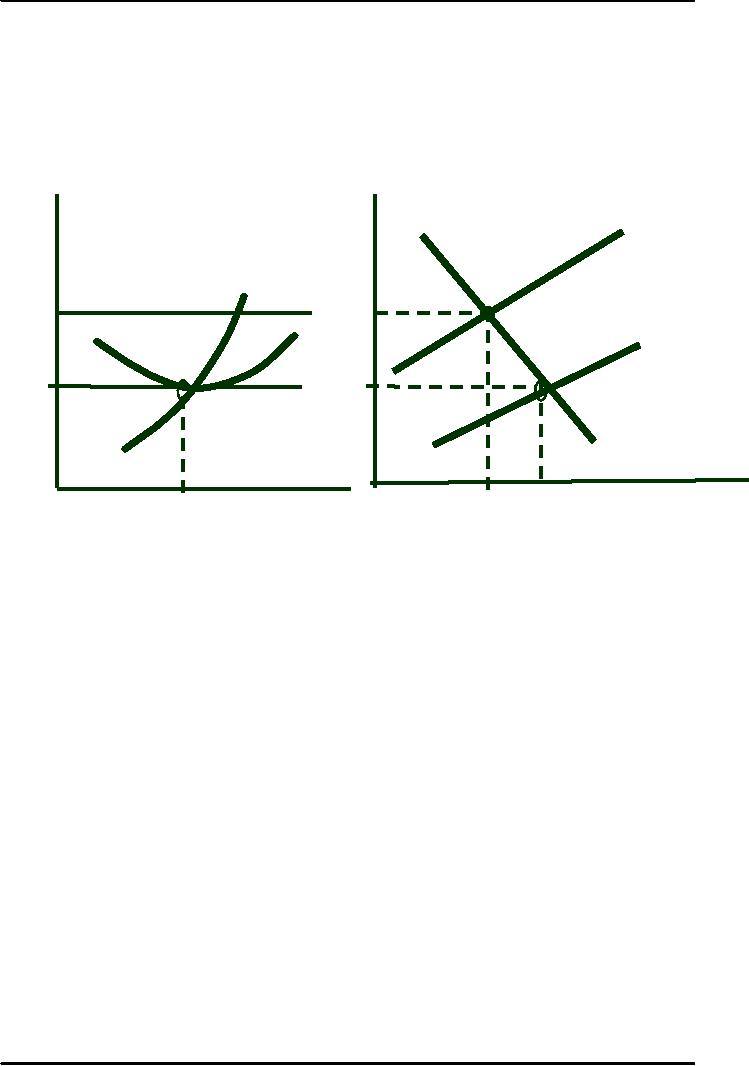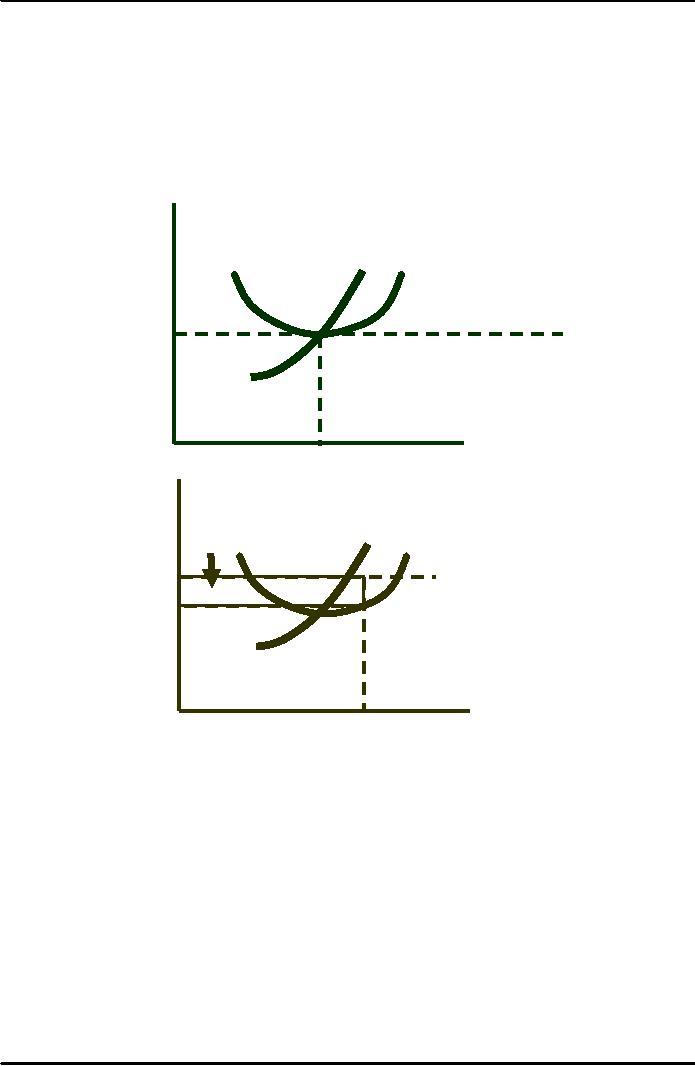 |
Elasticity of Market Supply:Long-Run Competitive Equilibrium |
| << Elasticity of Market Supply:Producer Surplus for a Market |
| Elasticity of Market Supply:The Industryís Long-Run Supply Curve >> |

Microeconomics
ECO402
VU
∑
The
long-run response to short-run
profits is to increase output
and profits.
∑
Profits
will attract other
producers.
∑
More
producers increase industry
supply which lowers the
market price.
Long-Run
Competitive Equilibrium
∑Profit
attracts firms
∑Supply
increases until profit =
0
$
per
Firm
Industry
$
per
unit
of
S
unit
of
output
output
LMC
P
$40
S
LAC
$3
P
0
2
D
Q2
Q
Output
q2
Output
Long-Run
Competitive Equilibrium
1)
MC
= MR
2)
P
= LAC
∑
No incentive to
leave or enter
∑
Profit =
0
3)
Equilibrium
Market Price
Questions
1)
Explain the market
adjustment when P < LAC
and firms have identical
costs.
2)
Explain the market
adjustment when firms have
different costs.
3)
What is the opportunity cost
of land?
Economic
Rent
Economic rent
is the difference between
what firms are willing to
pay for an input
less
the
minimum amount necessary to
obtain it.
An
Example
Two firms
A
&
B
Both own
their land
A
is
located on a river which
lowers A's
shipping
cost by $10,000 compared to
B
124

Microeconomics
ECO402
VU
The demand
for A's
river
location will increase the
price of A's
land
to $10,000
Economic rent =
$10,000
∑
$10,000 -
zero cost for the
land
Economic rent
increases
Economic profit
of A
=
0
Firms
Earn Zero Profit in Long-Run
Equilibrium
A
baseball team
Ticket
in
a moderate-sized
Price
city
sells enough
tickets
so that price
is
equal to marginal
LMC
LAC
and
average cost
(profit
= 0).
$7
Season
Tickets
Sales
(millions)
1.0
Ticket
Price
LMC
LAC
Economic
Rent
$10
A
team with the
same
$7
cost
in a larger city
sells
tickets for $10.
Season
Tickets
Sales
1.3
(millions)
With
a fixed input such as a
unique location, the
difference between the cost
of production
(LAC
= 7) and price ($10) is the
value or opportunity cost of
the input (location)
and
represents
the economic rent from
the input.
If
the opportunity cost of the
input (rent) is not taken
into consideration it may
appear that
economic
profits exist in the
long-run.
125
Table of Contents:
- ECONOMICS:Themes of Microeconomics, Theories and Models
- Economics: Another Perspective, Factors of Production
- REAL VERSUS NOMINAL PRICES:SUPPLY AND DEMAND, The Demand Curve
- Changes in Market Equilibrium:Market for College Education
- Elasticities of supply and demand:The Demand for Gasoline
- Consumer Behavior:Consumer Preferences, Indifference curves
- CONSUMER PREFERENCES:Budget Constraints, Consumer Choice
- Note it is repeated:Consumer Preferences, Revealed Preferences
- MARGINAL UTILITY AND CONSUMER CHOICE:COST-OF-LIVING INDEXES
- Review of Consumer Equilibrium:INDIVIDUAL DEMAND, An Inferior Good
- Income & Substitution Effects:Determining the Market Demand Curve
- The Aggregate Demand For Wheat:NETWORK EXTERNALITIES
- Describing Risk:Unequal Probability Outcomes
- PREFERENCES TOWARD RISK:Risk Premium, Indifference Curve
- PREFERENCES TOWARD RISK:Reducing Risk, The Demand for Risky Assets
- The Technology of Production:Production Function for Food
- Production with Two Variable Inputs:Returns to Scale
- Measuring Cost: Which Costs Matter?:Cost in the Short Run
- A Firmís Short-Run Costs ($):The Effect of Effluent Fees on Firmsí Input Choices
- Cost in the Long Run:Long-Run Cost with Economies & Diseconomies of Scale
- Production with Two Outputs--Economies of Scope:Cubic Cost Function
- Perfectly Competitive Markets:Choosing Output in Short Run
- A Competitive Firm Incurring Losses:Industry Supply in Short Run
- Elasticity of Market Supply:Producer Surplus for a Market
- Elasticity of Market Supply:Long-Run Competitive Equilibrium
- Elasticity of Market Supply:The Industryís Long-Run Supply Curve
- Elasticity of Market Supply:Welfare loss if price is held below market-clearing level
- Price Supports:Supply Restrictions, Import Quotas and Tariffs
- The Sugar Quota:The Impact of a Tax or Subsidy, Subsidy
- Perfect Competition:Total, Marginal, and Average Revenue
- Perfect Competition:Effect of Excise Tax on Monopolist
- Monopoly:Elasticity of Demand and Price Markup, Sources of Monopoly Power
- The Social Costs of Monopoly Power:Price Regulation, Monopsony
- Monopsony Power:Pricing With Market Power, Capturing Consumer Surplus
- Monopsony Power:THE ECONOMICS OF COUPONS AND REBATES
- Airline Fares:Elasticities of Demand for Air Travel, The Two-Part Tariff
- Bundling:Consumption Decisions When Products are Bundled
- Bundling:Mixed Versus Pure Bundling, Effects of Advertising
- MONOPOLISTIC COMPETITION:Monopolistic Competition in the Market for Colas and Coffee
- OLIGOPOLY:Duopoly Example, Price Competition
- Competition Versus Collusion:The Prisonersí Dilemma, Implications of the Prisoners
- COMPETITIVE FACTOR MARKETS:Marginal Revenue Product
- Competitive Factor Markets:The Demand for Jet Fuel
- Equilibrium in a Competitive Factor Market:Labor Market Equilibrium
- Factor Markets with Monopoly Power:Monopoly Power of Sellers of Labor